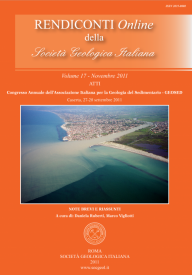
Stratigraphic architecture of an outer ramp/basinal turbidite fan carbonate system in a foreland basin ("Scaglia Toscana" Fm., Chianti Mts, Northern Apennines, Italy)
Cornamusini G. (*,**), Ielpi A. (*), Bonciani F. (**) & Callegari I. (**)
(*) Dipartimento di Scienze della Terra, Università di Siena. E-mail: cornamusini@unisi.it; ielpi@unisi.it
(**) Centro di Geotecnologie, Università di Siena.
Volume: 17/2011
Pages: 71-76
Abstract
The Chianti Mts, part of the Northern Apennines orogen, represent an ideal case study to depict the relationships between outer carbonate ramps and basin plain carbonate turbidite systems
in foreland basins. The main object of this research is the "Scaglia Toscana" Fm., a ca. 200 metres thick Eocene-Oligocene succession of polychromous shales, marls, pelagic limestones and turbidite calcarenites, with marked lateral/vertical complexity, having its type-section in the Chianti Mts. During fi eldwork, the fm. has been subdivided in four partially interfingered members (from the bottom and northernmost): Sugame Marls; Cintoia Shales; Montegrossi Calcarenites; Dudda Shales and Limestones. The formation relates to three depositional systems: a middle to outer carbonate ramp dominated by hemipelagic deposition; a basinal plain whose sediments distribution was mainly forced by redox/oxic conditions and calcite-lysocline fluctuations; a thinning- and fining-upward, coarse- to fine-grained carbonate turbidite system. The "Scaglia Toscana" basin was located on the Adria continental micro-plate, foreland of the developing Northern Apennines orogen, whose facies distribution was mainly controlled by block faulting and differential subsidence. The Chianti Mts. represent then a crucial sector, since they expose the junction between a northern SSE-dipping ramp and a southern basinal plain with turbidite fl oor fans. A general southwardand upward-shift from ramp, basinal plain and turbidite fan facies has been recognized and remarked since the pioneering studies of the 1960s. Nonetheless, an exhaustive facies and architectural analysis is still lacking in literature. To fill this gap, the partial and preliminary results of a field logging, integrated with sedimentary facies analysis are reported here.
Keywords
Get Full Text